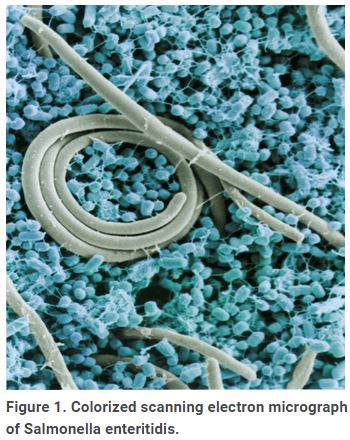



Environmental Control Needed to Achieve Best Results with Salmonella Vaccination
US - Our industry has made great progress reducing food-borne Salmonella in poultry products, but we still have a long way to go.According to one estimate, 93 million cases of human gastroenteritis still occur globally due to Salmonella and of these, 80.3 million can be attributed to food [1], writes Carl Heeder, DVM, a technical services veterinarian for Zoetis Inc.
Vaccination remains an important tool for managing the risk for food-borne Salmonella in poultry, but vaccines can be overwhelmed if environmental exposure to the pathogen isn’t well controlled, Mr Heeder writes in Poultry Health Today.
Birds can be exposed to Salmonella in the environment from multiple sources. The presence of Salmonella in poultry feed, for instance, is well documented. Research indicates that pelleting may reduce but won’t eliminate Salmonella contamination. [2]
Other important sources are rodents and flies. Consider that just one rodent dropping can have 104 to 106 Salmonella. [3]
When researchers placed flies into rooms containing hens challenged with the S. enterica serovar Enteritidis (Figure 1), 40 per cent to 50 per cent of them were contaminated at 48 hours. When five infected flies were fed to naïve hens, 30 per cent of the hens became positive. [4]
Darkling beetles are an issue for floor-raised birds. Much like flies, these pests have been identified as vectors for a number of pathogens — including Salmonella.
Let’s not forget wild birds and farm pets, which can transmit Salmonella. Both should be kept away from poultry flocks.
People are yet another potential Salmonella vector. All poultry farms should have biosecurity procedures in place to control who comes onto the premises. Only necessary personnel should enter poultry houses and they should be required to wear protective clothing and disinfected boots.
Cleaning and disinfection of equipment and poultry houses are likewise essential components of good Salmonella control. Remember that all organic material, which includes feed, faeces and feathers, must be removed and surfaces cleaned before disinfecting, otherwise disinfection won’t work. [5]
Be sure to use disinfectants specifically labeled as active against Salmonella spp. They will work best on nonporous surfaces and since they take time to work, they should be left on clean, dry surfaces for the maximum contact time. For areas that are hard-to-reach, fogging products are available and some of them are extremely effective against Salmonella spp.
Vaccine selection
Once environmental control of Salmonella is in place, consider vaccine selection carefully. You’ll get better results if you select vaccines that are as close as possible to the serotypes of Salmonella affecting a farm. Like all vaccines, Salmonella vaccines must be stored, handled and administered properly.
Salmonella-vaccination programs can consist of either inactivated or modified-live vaccines or a combination, depending on a farm’s needs. The use of both types of vaccines provide the most complete protection and Salmonella risk reduction.
Live Salmonella vaccines prime the immune system by stimulating gut-associated lymphoid tissue and cellular immunity. [6] They are thought to be fast-acting, provide early protection, and may provide cross-protection within serogroups. [7] Inactivated Salmonella vaccines provide serotype-specific immunity and may help reduce the transmission of Salmonella. [8]
Regardless of which type of vaccine you use, it’s important to follow the recommended protocol — for both dose rate and number and timing of the doses — to protect flocks effectively.
Experience to date
Providing poultry meat and eggs that are completely Salmonella-free is a tall order for the global poultry industry. Denmark has come close by implementing wide-ranging reforms that included the elimination of infected breeding flocks as well as vaccination and improved sanitation and biosecurity, although the result has also been high chicken prices for consumers. [9]
In the US, vaccination of breeder flocks has been shown to result in a lower prevalence of Salmonella in the ceca and reproductive tracts of hens, a lower Salmonella prevalence in broiler chicks, fewer environmental samples containing Salmonella on broiler farms and a lower prevalence in broilers entering processing plants. [10]
In England and Wales, an epidemic of human Salmonella enterica serovar Enteritidis was associated with consumption of contaminated chicken meat and eggs. A decline in the number of infections began after adoption of vaccination and other measures aimed at controlling Salmonella during production and distribution. [11]
The experience in these and other countries has demonstrated that it is possible for our industry to make significant reductions in the prevalence of Salmonella in poultry meat and eggs with the use of vaccines, especially if used in combination with good husbandry and environmental control of Salmonella.
References
[1] Majowicz, S, et al. The Global Burden of Nontyphoidal Salmonella Gastroenteritis. Clinical Infectious Diseases 2010;50:882-889.
[2] Jones, FT. A review of practical Salmonella control measures in animal feed. 2011 J. Appl. Poult. Res. 20:102-113.
[3] Davies RH and Wray C, Observations on disinfection regimens used on Salmonella enteritidis infected poultry units. Poultry Sci 74:638–647 (1995).
[4] Holt, et al. Isolation of Salmonella enterica Serovar Enteritidis from Houseflies (Musca domestica) Found in Rooms Containing Salmonella Serovar Enteritidis-Challenged Hens. Appl. Environ. Microbiol. October 2007 vol. 73 no. 19 6030-6035
[5] On-Farm Salmonella Control Measures for Layers. Cleaning and Disinfection. Zoetis Inc.
[6] Heeder, C. Managing Salmonella Risk. PowerPoint, Zoetis.
[7] Salmonella vaccination program. Zoetis Inc. https://www.zoetisus.com/freefromse/vaccination-program.html Accessed June 23, 2015.
[8] Ibid.
[9] Can We Get to Zero Salmonella in Poultry? WETA Frontline, May 12, 2015.
http://www.pbs.org/wgbh/pages/frontline/health-science-technology/trouble-with-chicken/can-we-get-to-zero-salmonella-in-poultry/ Accessed June 23, 2015.
[10] Dorea F, et al. Effect of Salmonella Vaccination of Breeder Chickens on Contamination of Broiler Chicken Carcasses in Integrated Poultry Operations. Appl. Environ. Microbiol. December 2010 vol. 76 no. 23 7820-7825.
[11] Lane, C, et al. Salmonella enterica Serovar Enteritidis, England and Wales, 1945-2011. Emerg Infect Dis. 2014 Jul;20(7):1097-1104.













